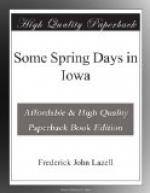Purple finches, a bit late in the season, are feeding on the seeds of the big elm. The snows of late April and early May must have delayed their journey northward. When the bird-designer made this bird he set out to make a different kind of sparrow, but then had pity upon the amateur ornithologist who finds the sparrows even now almost as difficult to classify as the amateur botanists do their asters; so he dipped the bird in some raspberry juice—John Burroughs says pokeberry juice—and the finch came out of the dye with a wash of raspberry red on his head, shoulders and upper breast, brightest on the head and the lower part of his back. Otherwise he looks much like an English sparrow.
* * * * *
Now the belated April flowers are seen at their best, mingled with many of the May arrivals. It is such a day as that when Bryant wrote “The Old Man’s Counsel.” On the sloping hillsides, around the leafing hazel “gay-circles of anemones dance on their stalks.” In the more open places the little wind flower, with its pretty leaves and solitary white blossoms, blooms in cheerful companionship with its fellows, and the more sterile parts of the hillside are snowed with the white plumes of the plantain-leaved everlasting. Downy yellow violets and the common blue violets grow everywhere and down on the sand near the river the birdfoot violet, with its quaintly cut leaves and handsome blossoms grows abundantly for the children who love to gather the “sand violets.” On the bottom which was flooded in March the satiny yellow flowers of the marsh buttercup shine and the beautiful green of the uplands is spotted with the pure gold of the buttercup. There is no longer need to be satisfied with a few pretty flowers. May scatters her brightest and best in abundance. On the rocky slopes the wild ginger shows its red-brown, long-eared urns, the white baneberry its short white plumes, the branchlets of the bladdernut are breaking into white clusters and columbine soon will “sprinkle on the rocks a scarlet rain” as it did in Bayard Taylor’s time, although the “scarlet rain,” like that of the painted cup in the lowlands, grows less and less each year. The white glory of the plum thickets at its height and the hawthornes, whose young leaves have been a picture of pink and red, will soon break into blossom and vie with the crabapple thickets in calling attention to the beauty of masses of color when arranged by the Master Painter.
* * * * *
The carpet of the woodlands grows softer and thicker, and more varied each day. Ferns and brakes are coming thickly. The flowers grow more splendid. The large, wholesome looking leaves of the blue bell are a fitting setting for the masses of bloom which show pink in the bud, then purple, and lastly a brilliant blue. Jack-in-the-pulpits make us smile with keen pleasure as memories of happy childhood days come crowding thickly upon us. The pretty pinnate




